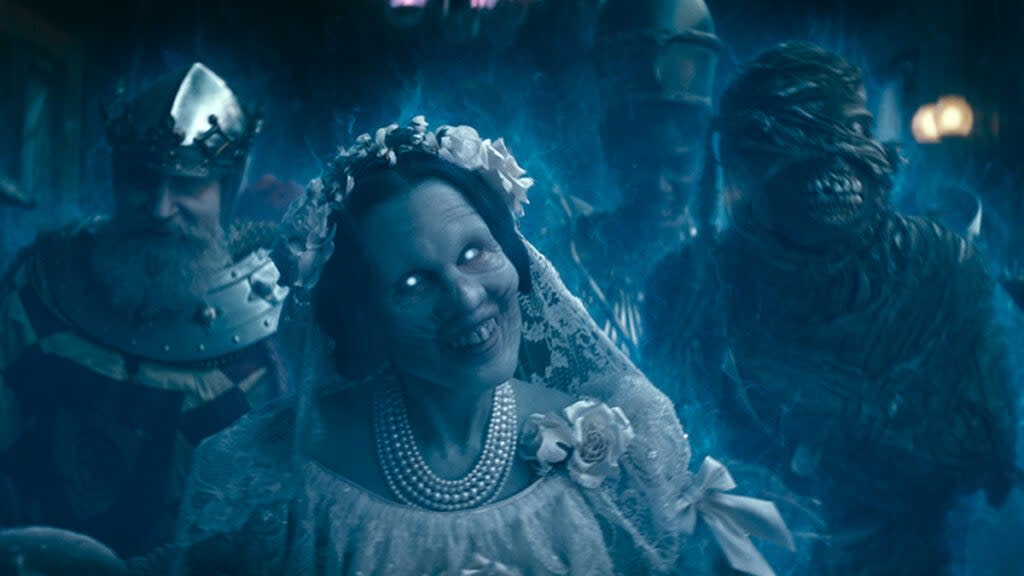How ‘Haunted Mansion’ Integrated Both Versions of the Ride Into Its Sets

It was an honor for production designer Darren Gilford to work on Disney’s new adaptation of “Haunted Mansion.” As one of the first creative Imagineering interns in the ’90s, the attraction has always held a soft spot for Gilford. “It was an opportunity to do something very different,” he told TheWrap. “I’ve never done [something like] this. I’ve only done one other period piece before.” And to see the finished product on the screen, Gilford and his team knew their Haunted Mansion history.
“When we started the project, we had a bible. An Imagineering Haunted Mansion bible which is like a sacred document,” he said. That bible laid out all the nitty-gritty about the ride, which the design team employed to craft recreations of the ride’s iconic portraits, as well as the wallpaper and various other items found inside the house. “There were so many Easter eggs in the details,” Gilford said. One of which was the way the paintings were crafted. The desire was to update them for the movie, as opposed to making carbon copies from the ride, but still making them authentic to the house’s time period.
“We studied the original paintings,” he said. “We changed things to fit our story and proportions, and we painted them all digitally. They’re all painted in the computer, then we print them to the right sizes, and then we overpaint them to get the texture, to make it feel like real oil paintings.”
Gilford went on to talk about integrating both the Disneyland and Disney World versions of the Haunted Mansion for the film.
Note: Spoilers for “Haunted Mansion” are below.
Were there films you drew inspiration from for this?
I’m a fan of horror for the scares. I was excited to do a scary movie and [find out] how you design for some of those sequences. “Haunted Mansion” is a perfect blend between scares and humor, and that’s the beauty of it. That’s exactly the fine line that we needed to walk with the movie. I was looking at a lot of haunted house movies because I wanted to see how they were shot, how they’re composed.
There were a couple of really old ones from the ’50s that we looked at. Maybe it was “The Haunting?” We were looking at those for the in-camera gags, the mirror gags and some of those compositions, which were fun. And then I was looking at more modern-day films for the Victorian architecture.
You have both the Florida and California versions of the Mansion in here. What went into designing both?
The Haunted Mansion from Anaheim is the one that I’m most familiar with and I have most affinity for, it’s the original one. I knew that was going to be Gracey’s mansion. We knew that we were going to be in New Orleans, we were going to be in the bayou. It made perfect sense that that was just the natural fit for the exterior, and for a lot of the interior rooms and things we were going to be in that lane. The Florida mansion was what we used for what we call Crump Mansion, and that was based in New England. We liked the red brick, and the design and the architecture of the Florida Haunted Mansion.
We found a great location in Atlanta that we used the grounds for and the staircase going up to it, and then we composited that house in the background for the exterior. But the interior we wanted very, very different. I pushed Justin [Simien] really hard to have a strong contrast between all the texture and color that we’re going to be familiar with, with Gracey to do something different with, and cold and clinical for Crump. I wanted to do a white, gray marble interior, stone cold interior for a lot of those rooms. Those were all sets. I wanted it to feel skeletal, almost like it was made out of skeleton bone or something like that. It was great, all the stones in the floor, all the marble and all the sculpture, the white alabaster was really fun.
“Haunted Mansion” is in theaters now.
This interview has been edited and condensed for clarity.
The post How ‘Haunted Mansion’ Integrated Both Versions of the Ride Into Its Sets appeared first on TheWrap.


